Throughout history, the resolute spirit of rail travel has traversed continents, uniting the world with a symphony of steel and steam. Majestic locomotives, with their powerful and relentless drive, have carried us on a journey of discovery and connection. From the grandeur of the Trans-Siberian Railway to the enchanting charm of the Orient Express, these feats of engineering have woven tales of adventure, aspiration, and innovation, whispering stories of untamed landscapes, bustling cities, and the dreams of pioneers. Rail travel, an enduring testament to human ingenuity, continues to evoke a sense of wonder, inspiring us to embark on extraordinary adventures.
The history of rail travel dates back to the early 19th century when the invention of the steam locomotive sparked a revolution in transportation.
The first public railway, the Stockton and Darlington Railway, opened in England in 1825, marking the dawn of a new era. Railways quickly spread across Europe and North America, transforming economies and societies.

In 1830, the world's first intercity railway, the Liverpool and Manchester Railway, began operations, pioneering the concept of scheduled passenger services. This breakthrough led to the rapid expansion of railways globally, with networks crisscrossing continents. The United States saw tremendous growth, aided by the completion of the First Transcontinental Railroad in 1869, connecting the East and West coasts.
The late 19th and early 20th centuries witnessed remarkable advancements in rail technology. Electric and diesel-powered locomotives replaced steam engines, allowing for faster and more efficient travel. Iconic trains like the Orient Express and the Trans-Siberian Railway captured the imagination of adventurers and explorers.
Today, high-speed rail systems, such as Japan's Shinkansen and the Franco-British Eurostar, provide rapid and comfortable transportation options. Railways continue to evolve, incorporating cutting-edge technology like maglev trains and exploring sustainable solutions for the future.
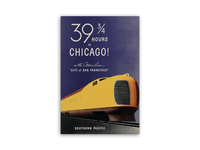
Designer Unknown for AT&SF / 1936
Promoting the flagship streamliner locomotive of the Atchison, Topeka and Santa Fe Railway, boasting the then record-breaking 39 hour, 45 minute journey from Los Angeles to Chicago. The locomotive was called the Super Chief, though it became known as the 'Train of the Stars' for carrying celebrities such as Elizabeth Taylor, Lauren Bacall, Judy Garland and Bing Crosby.
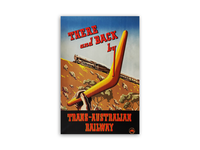
Gordon Andrews for Commonwealth Railways / 1940-1959
The Trans-Australian Railway is one of Australia's longest operating railways, connecting Sydney with Perth and covering a distance of 1,691km (1,051mi). Although largely used for freight, two passenger services currently use the track; the Indian Pacific running between Sydney in the east and Perth in the west via Adelaide, and The Ghan between Darwin in the north and Adelaide in the south via Alice Springs.
Gordon Andrews, a renowned designer, produced many public transport posters for the Australian government, being commissioned by the UK and Italian governments, before going on to design the first decimal bank notes of Australia in 1966.
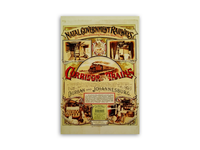
Designer Unknown for Natal Government Railways / c.1896
Now the KwaZulu-Natal province of South Africa, the Natal Colony was, from 1843 to 1910, under British rule hence the early arrival of railways in southern Africa. The Natal Government established a railway network in 1877 which grew to operate over 1,580km of track by 1910. Rail travel boomed in the late 1880s when gold was discovered in Johannesburg, sparking the birth of the Corridor Train service from Durban to Johannesburg.
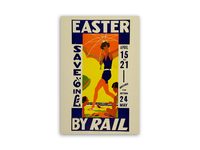
Designer unknown / 1930
As war was waged in Europe, New Zealand civilians enjoyed a relatively sheltered life thanks to the country's location, over 18,000km away from Nazi Germany. Boasting substantial savings for families who travel by train for their Easter holidays, the poster employs a then popular technique: the objectification and stylisation of the female body to attract male viewers. For most of the early half of the 20th century, men were the primary household earners, leading to many travel companies producing adverts exclusively for a male audience, focusing on a subject rather than the destination.
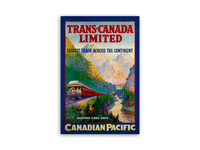
Designer unknown / 1924
The Canadian Pacific Railway launched in 1881 as the country's first transcontinental rail route. Departing from Montreal, the six-day journey chugged through some of Canada's most beautiful landscapes including the Rocky Mountains, before arriving at Port Moody in British Columbia. At the time of construction, it was the longest railway line ever constructed and took a significant amount of manpower, investment and political will from a country with a relatively small population, limited capital and difficult terrain.
Canadian Pacific, now merged with Kansas City Southern, still operates today, connecting Canada with the USA and Mexico, and operating over 32,000km of track.
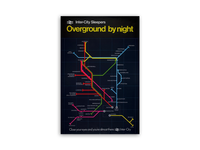
British Railways Board and Lonsdale and Bartholomew Limited / 1974
In 1966, British Rail introduced InterCity, a long-haul, express passenger rail service linking cities across Britain, France and Belgium. Passengers could travel to most of Britain's major cities including Paris and Brussels via British Rail's Night Ferry, Larne and Belfast via the Belfast Boat Express from Stranraer, and Dublin via the Irish Mail passenger service from Holyhead.
This poster, designed in the style of London's famous underground map by Harry Beck in 1931, advertised British Rail's new sleeper train service under the slogan 'close your eyes and you're almost there'.
By Road & Rail Holidays
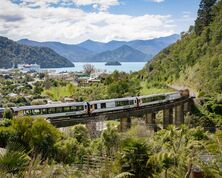
Year Round • from £7,599 pp.
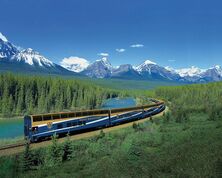
from £7,499 pp.
Ben Tully
Visual Design & Content Creation
Ben deals with all things design, working on the visual design of our annual guides, Destinations magazine, information leaflets, social media and email campaigns, and much more across the Alan Rogers, Rallies and Worldwide brands. He also produces written content for our blogs alongside our other contributors.
More by Ben TullyRecent Blog Posts
-
Unearthing Australia's Underground Towns
April 24, 2024 -
Haida Gwaii: Canada's Remote Archipelago
April 18, 2024 -
Faces of Value: The Million Dollar Icons of Australia
April 10, 2024 -
Guest Post: Two Travellers, One Motorhome, and Wonderful New Zealand
March 22, 2024 -
Inspirational Places to Visit Around the World
March 13, 2024
